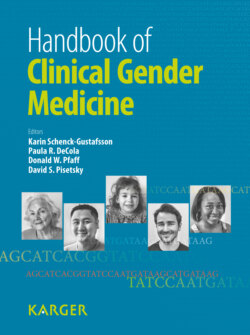Читать книгу Handbook of Clinical Gender Medicine - Группа авторов - Страница 45
На сайте Литреса книга снята с продажи.
Effects of Intrauterine Testosterone
ОглавлениеThe male gonad commences testosterone secretion as early as the 7th week of pregnancy. Testosterone levels peak around 14-18 weeks of gestation and testosterone levels in the developing male fetus may become close to adult levels. Testosterone exerts manifold effects on the developing organism, like sex-specific development of genitalia and growth rate. The effect of fetal sex steroids on mammalian brain development is most striking. Dependent on the availability of testosterone receptors, testosterone affects cell apoptosis and is involved in the establishment of neural connectivity. The results of this development are far reaching and are of crucial importance for ‘male’ behavior after birth and throughout life, including childhood play behavior, and may also be involved in the establishment of sexual orientation and sexual identity. High exogenous or endogenous testosterone levels in female embryos (or neonates) will lead to behavior patterns typical of males. On the other hand, neonatal castration in male rats or rhesus monkeys will lead to typical female behavior. In humans, much insight related to the effect of increased intrauterine levels of androgens has been gained from observations in females with congenital adrenal hyperplasia (CAH), a genetic disorder with autosomal recessive heritance. Affected individuals lack the enzyme 21 - hydroxylase (21 - OH) and produce therefore high levels of testosterone by the end of the first trimester of pregnancy. Phenotypically, these girls are born with various degrees of genital virilization or ambiguous genitalia. In spite of successful postnatal correction of the hormonal imbalance by corticosteroid treatment, affected females often present with various degrees of boy-typical behavior including toy preference. Later in life, women with CAH tend to be more often homosexual or bisexual than unaffected sisters or controls [6] and they may later in life show lower verbal capabilities, enhanced spatial abilities, and increased aggression during adolescence - all features which are usually associated with ‘maleness’. An opposite experiment of nature is the X-linked ‘androgen insensitivity syndrome (AIS)’ in genetic males, which is characterized by adequate intrauterine testosterone secretion but lack of functional receptors. Affected individuals are very rarely diagnosed postnatally as they are born as phenotypical females and also develop later in life as females, including behavior patterns, core gender identity, and sexual preference. Since affected individuals lack a uterus and ovaries, they usually present with primary amenorrhea which is not responsive to sex steroid treatment. Both CAH and AIS clearly demonstrate the crucial role played by intrauterine androgen levels and its functional receptors on subsequent physical, behavioral, and cognitive development. Excessive prenatal exposure to testosterone has been implicated in the development of dyslexia and autism [7]. On the other hand, reduced levels of fetal testosterone can be found in situations where the pregnant women is under acute and chronic stress, such as in times of war or when exposed to natural or personal disasters. Prenatal maternal stress and anxiety have been shown to be associated with impaired neurodevelopmental outcomes, including attention deficit and hyperactivity in boys [8].
